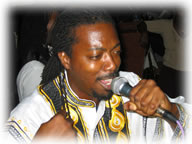|

|
Could not connect to db
|
My Garifuna -> Gari-History
|
THE ORIGIN OF THE GARIFUNA |
01/16/03
By: James Lovell
|
 “I AM CARIB, I AM ARAWAK, I AM AFRICAN AND I AM A GARIFUNA.”
“I AM CARIB, I AM ARAWAK, I AM AFRICAN AND I AM A GARIFUNA.”
When someone says,“I am a Garifuna,” that person is acknowledging the fact that she/he has Carib, Arawak and African blood pumping from their heart and through their veins. Because, the Garifuna Nation is a hybrid race which included the Carib and Arawak Nations of South America and the Caribbean, and the West Africans from Mali. Over a period of time, every aspect of the Garifuna Nation-i.e. Language, Music, Customs, Diet and Divination- was affected by these three nations. After reading many books about the Caribs, Arawaks and Africans, European Scholars consistently and deliberately regurgitated the myth that Caribs were savages, and that the Africans were ignorant. Therefore the main reason this report was written was to make correction to the European Myth, and to set the record straight once and for all. As a living Descendant of Carib Ancestry, I will write and proclaim the glorious achievement of my progenitors. On that note, lets talk about the Caribs. Who are these People? From where did they came?
THE CARIBS AND ARAWAKS
“I AM CARIB, I AM ARAWAK, I AM AFRICAN, I AM A GARIFUNA.”
The Caribs and Arawaks were inhabitants of the Amazon Basin in South America, which is located at the northeastern region of Guyana. These two nations share similar characteristics, which includes: red
/yellow complexion, 5 feet 4inches in height, medium built, straight hair and hazel/gray eyes. The Caribs and Arawaks were Farmers and Fishermen, who lived in harmony and peace with each other. One of the main differences between these two nations was their Language. For example, the mother would tell her son higabunu, which means come here. While the father would say ahuye, which also means come here. This difference in the language between the male and female Garifuna is very much evident in any Garifuna community today. These people invented the hammocks and the Bar-b- cue grill. There are artifacts that were excavated in Grenada, St. Vincent and other Caribbean Islands, which proved beyond a doubt how resourceful and brilliant these Nations were, contrary to what was written about them from an outsider’s perspective.
THE ARRIVAL OF THE WEST AFRICANS
“I AM CARIB, I AM ARAWAK, I AM AFRICAN, AND I AM A GARIFUNA.”
In the early 1300s, the Mali Empire was the leading country in technology. King Abubakari, brother of Mansa Musa the emperor, ventured on a journey to expand trade and commerce with other countries. With over two thousand sailors, Abubakari sailed away with ships laden with precious stones, gold, fruits, plants and agricultural tools. During the journey, these brave sailors separated and drifted apart. As a result they landed in the Americas and the Caribbean. Take note, that this great African accomplishment took place before Columbus accidentally landed in the Caribbean august 12th, 1492. The Africans came in peace, sharing their knowledge with the red Caribs and Arawaks. The Africans who eventually remained in the Caribbean intermarried into the Caribs and Arawaks. Since the Africans have different characteristics from that of their hosts, their offspring were dark in complexion, had coarse hair, a slender build and an average of 5 feet 9 inches in height. Eventually, these new offspring would become known as the Black Caribs or the Garifuna People. From the heart and soul of James Lovell.
|
|

|
|
|
|